A region-confined PROTAC nanoplatform for spatiotemporally tunable protein degradation and enhanced cancer therapy
- PMID: 39098906
- PMCID: PMC11298519
- DOI: 10.1038/s41467-024-50735-w
A region-confined PROTAC nanoplatform for spatiotemporally tunable protein degradation and enhanced cancer therapy
Abstract
The antitumor performance of PROteolysis-TArgeting Chimeras (PROTACs) is limited by its insufficient tumor specificity and poor pharmacokinetics. These disadvantages are further compounded by tumor heterogeneity, especially the presence of cancer stem-like cells, which drive tumor growth and relapse. Herein, we design a region-confined PROTAC nanoplatform that integrates both reactive oxygen species (ROS)-activatable and hypoxia-responsive PROTAC prodrugs for the precise manipulation of bromodomain and extraterminal protein 4 expression and tumor eradication. These PROTAC nanoparticles selectively accumulate within and penetrate deep into tumors via response to matrix metalloproteinase-2. Photoactivity is then reactivated in response to the acidic intracellular milieu and the PROTAC is discharged due to the ROS generated via photodynamic therapy specifically within the normoxic microenvironment. Moreover, the latent hypoxia-responsive PROTAC prodrug is restored in hypoxic cancer stem-like cells overexpressing nitroreductase. Here, we show the ability of region-confined PROTAC nanoplatform to effectively degrade BRD4 in both normoxic and hypoxic environments, markedly hindering tumor progression in breast and head-neck tumor models.
© 2024. The Author(s).
Conflict of interest statement
The authors declare no competing interests.
Figures
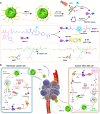
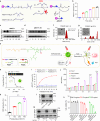
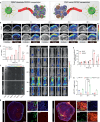

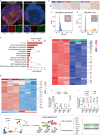
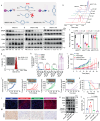

Similar articles
-
Tumor-targeted PROTAC prodrug nanoplatform enables precise protein degradation and combination cancer therapy.Acta Pharmacol Sin. 2024 Aug;45(8):1740-1751. doi: 10.1038/s41401-024-01266-z. Epub 2024 Apr 12. Acta Pharmacol Sin. 2024. PMID: 38609561 Free PMC article.
-
Engineered bioorthogonal POLY-PROTAC nanoparticles for tumour-specific protein degradation and precise cancer therapy.Nat Commun. 2022 Jul 26;13(1):4318. doi: 10.1038/s41467-022-32050-4. Nat Commun. 2022. PMID: 35882867 Free PMC article.
-
Self-Oxygenating PROTAC Microneedle for Spatiotemporally-Confined Protein Degradation and Enhanced Glioblastoma Therapy.Adv Mater. 2025 Apr;37(13):e2411869. doi: 10.1002/adma.202411869. Epub 2025 Mar 3. Adv Mater. 2025. PMID: 40025927
-
Synthesis, SAR, and application of JQ1 analogs as PROTACs for cancer therapy.Bioorg Med Chem. 2024 Oct 1;112:117875. doi: 10.1016/j.bmc.2024.117875. Epub 2024 Aug 16. Bioorg Med Chem. 2024. PMID: 39178586 Review.
-
Stimuli-activatable PROTACs for precise protein degradation and cancer therapy.Sci Bull (Beijing). 2023 May 30;68(10):1069-1085. doi: 10.1016/j.scib.2023.04.028. Epub 2023 Apr 26. Sci Bull (Beijing). 2023. PMID: 37169612 Review.
Cited by
-
Prodrug Strategy for PROTACs: High Efficiency and Low Toxicity.ACS Omega. 2025 Jun 5;10(23):23926-23942. doi: 10.1021/acsomega.5c01241. eCollection 2025 Jun 17. ACS Omega. 2025. PMID: 40547641 Free PMC article. Review.
-
Sono-activable and biocatalytic 3D-printed scaffolds for intelligently sequential therapies in osteosarcoma eradication and defect regeneration.Nat Commun. 2025 Jul 4;16(1):6150. doi: 10.1038/s41467-025-61377-x. Nat Commun. 2025. PMID: 40610512 Free PMC article.
-
A Self-Immobilizing Photosensitizer with Long-Term Retention for Hypoxia Imaging and Enhanced Photodynamic Therapy.JACS Au. 2024 Oct 3;4(10):4032-4042. doi: 10.1021/jacsau.4c00787. eCollection 2024 Oct 28. JACS Au. 2024. PMID: 39483216 Free PMC article.
-
Precision-engineered PROTACs minimize off-tissue effects in cancer therapy.Front Mol Biosci. 2024 Nov 22;11:1505255. doi: 10.3389/fmolb.2024.1505255. eCollection 2024. Front Mol Biosci. 2024. PMID: 39649701 Free PMC article. Review.
-
PROTAC Delivery Strategies for Overcoming Physicochemical Properties and Physiological Barriers in Targeted Protein Degradation.Pharmaceutics. 2025 Apr 9;17(4):501. doi: 10.3390/pharmaceutics17040501. Pharmaceutics. 2025. PMID: 40284496 Free PMC article. Review.
References
MeSH terms
Substances
Grants and funding
- U22A20328/National Natural Science Foundation of China (National Science Foundation of China)
- 22074043/National Natural Science Foundation of China (National Science Foundation of China)
- 23ZR1475000/Science and Technology Commission of Shanghai Municipality (Shanghai Municipal Science and Technology Commission)
- 20430711800/Science and Technology Commission of Shanghai Municipality (Shanghai Municipal Science and Technology Commission)
- 19DZ2251100/Science and Technology Commission of Shanghai Municipality (Shanghai Municipal Science and Technology Commission)
LinkOut - more resources
Full Text Sources

